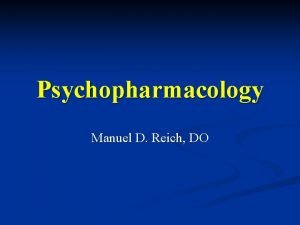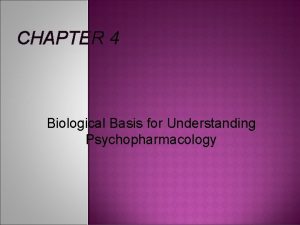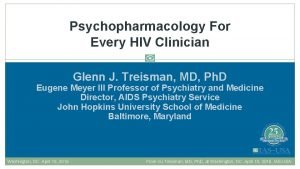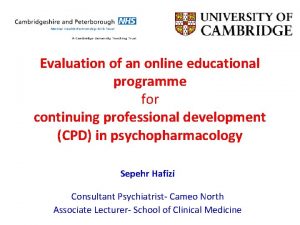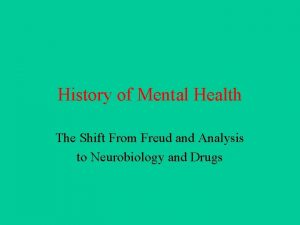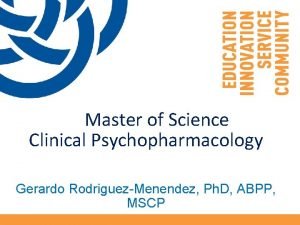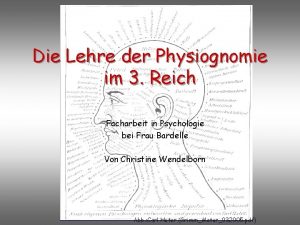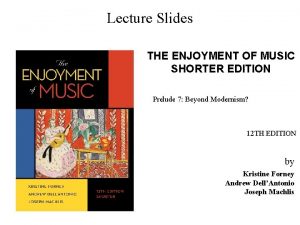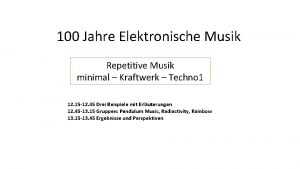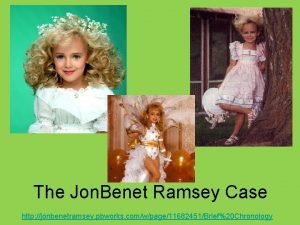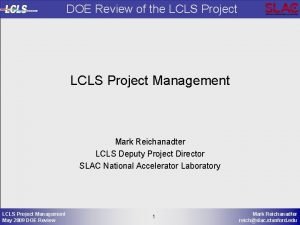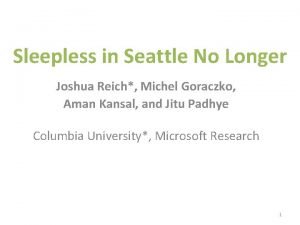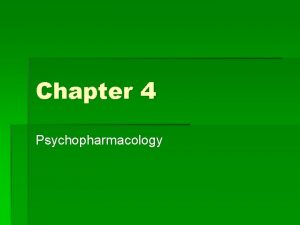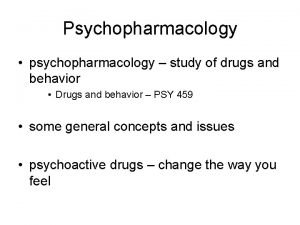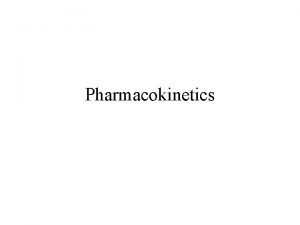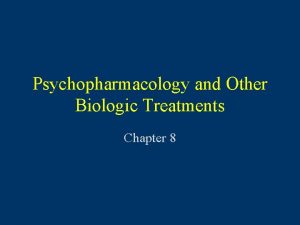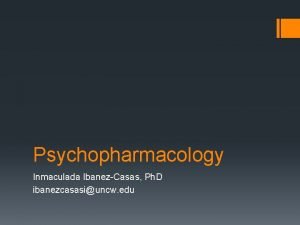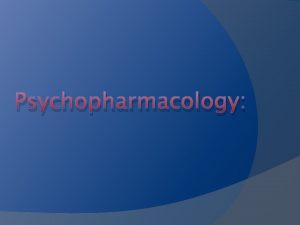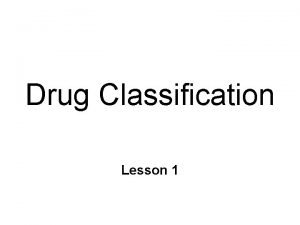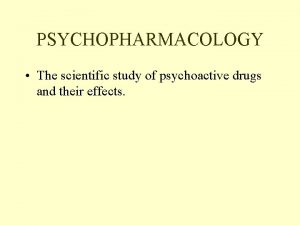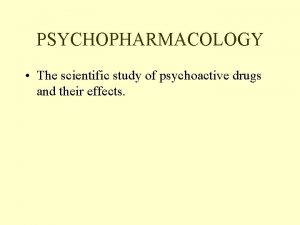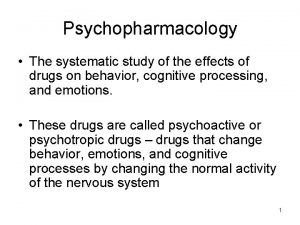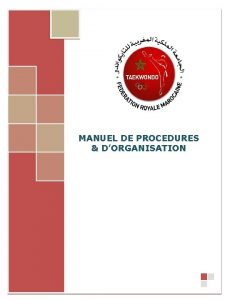Psychopharmacology Manuel D Reich DO Psychopharmacology The study






































- Slides: 38

Psychopharmacology Manuel D. Reich, DO

Psychopharmacology The study and practice of the effects that drugs have on mood and behavior n A wide range of substances from plant sources to metals n Neuropsychopharmacology: the relationship between drugs and the cells in the nervous system that casue change in mood and behavior n Psychoactive drugs cause chemical interactions between target receptors in the CNS n

History India: Fly Agaric 10, 000 BCE n Hunter/Gather/Tribes: Hallucinogenic Drugs n Farming: cannabis, opium herbs, farming societies fermentation alcohol n Scientific Revolution: rejection of herbs and natural preparations n 20 th Century: psychiatric drugs as a byproduct of organic compounds and reassessment of traditional remedies n

n n n Psychoactive Categories Antidepressants: TCA, MAOI, SSRI, SNRI, Other Alcohol; a depressant Anxiolytic: Benzodiazepines Antipsychotic: 1* , 2*, 3* Stimulants : Amphetamines Mood Stabilizer: Anti-seizure Hypnotic Cannabis Opiates: Narcotic analgesic Hallucinogens Hormones Neurotransmitters

Research & Development Chemical Models: n In relation to CNS anatomy and physiology Designed based on organic properties n Physical properties n Mechanical properties n Neurotransmitters n Re-evaluation of existing medications n

Specific Testing FDA Guidelines n Lab chemical analysis n Animal models n Human testing n Benefit over placebo n Distinct number of studies n

Mental Illness and Medications Significant percentage Americans suffers a diagnosable mental illness in any six month period n Significant percentage of these people will improve or recover if they get treatment n All medicines have effects based on their positive and negative effects Therapeutic effec n Chemical properties: n Side effect

Mental Illnesses and Medications People suffering from many mental illnesses have imbalances in brain physiology n The neurotransmitters ↓ Transmission ↑ Re-up take ∆ Production ? Anatomy ? Receptor – Neuroreceptor function n





Nomenclature n Diagnosis n n n Anti-depressant Anti-anxiety Anti-psychotic Anti-epileptic Physiological Action/ Administration SSRI NSRI Typical Stimulant Oral Atypical Transdermal Depot ODT

Chemical Formula n Receptor Clinical Effect n Mood Stabilizer n Pain n Anxiolytic n Hypnotic n Anesthesia n Recreation n Ritual/Spiritual n Military

Generic Name n Trade Name ® n Clinical Utilization n n FDA Indication n Age n Diagnosis n “Off Label” Use Pharma n Medical n

Anti-Depressants n n n Depression afflicts millions Americans in any six-month period Profound and unremitting sadness, hopelessness, helplessness, guilt and fatigue, no happiness or joy in activities once enjoyed or being irritable for greater than 2 weeks Depression can be lethal, patients are at high risk for suicide 80% of patients suffering from major illness respond well to treatment Psychiatrists usually recommend treatment with antidepressant medications for a minimum of six months after a 3 month stabilization period ( 9 -12 -18 months) Longer for multiple episodes especially after age 40

Anti-Depressant Medication n The classes of medication are used as anti -depressants Tricyclics n MAOIs n SSRI (Specific Serotonin Re-Uptake Inhibitors) n SNRI (Norepinephine Serotonin Re-uptake Inhibitors) n Tetracyclic n Other n

Tricyclic Anti-Depressants Elavil (Amitryptiline) n Norpramin (Despiramine) n Tofranil (Imipramine) n Pamelor (Nortryptiline) n

Tricyclic Antidepressants n Side Effects n Confusion n Blurred vision n Sweating n Constipation n Racing heartbeat n Light-headedness n Low blood pressure n Dry mouth n Allergic skin reactions n Retention of urine n Sensitivity to sun n Side effects generally disappear after a few weeks More serious side effects: n narrow-angle glaucoma seizures

MAOI’s Nardil n Marplan n Emsam n n Diet Considerations

Serotonin-Specific Agents n n n Prozac n Celexa n Luvox Zoloft n Paxil n Lexapro Less effect on the cardiovascular system (safer if overdose) Generally have fewer effects than other classes of anti-depressants Side Effects n n Anxious or nervous, sleep disturbances, stomach cramps, nausea, skin rash and, rarely, sleepiness Extremely rare cases may develop a seizure Discontinuation syndrome Serotonin syndrome

Serotonin – Norepinephrine Reuptake Inhibition (dual action) Fetzima n Effexor n Pristiq n Cymbalta n

Tetracyclics and Others Remeron n Ludiomil n Viibryd n Brintellix n

Mood Stabilizers n n Bipolar Disorder patients have symptoms of severe depression that alternate with periods of feeling normal and/or periods of excessive excitement and activity known as mania Manic Phases may include: n n n Extremely high energy Grandiose and unrealistic ideas Spending sprees Go for days without sleeping Thoughts become chaotic, speak rapidly

Mood Stabilizer – Anti. Epileptic Depakote n Tegretol n Lithium n Trileptal n Lamictal n Neurontin n Topomax n Atypical Anti-psychotics n

n n Treats manic symptoms in seven to ten days and reduces depressive symptoms Effective in controlling wild thoughts and behaviors of mania n Side Effects n n n Tremor Weight gain Nausea Diarrhea Confusion Slurred speech Fatigue Weakness Difficulty walking Blood count changes Liver changes Steven Johnson Syndrome

Atypical Anti-Psychotic Abilify n Zyprexa n Geodon n Seroquel n Risperdal n Rexulti n n Metabolic Syndrome

Anti-Anxiety Medications n n n Generalized anxiety Phobias – a strong persistent fear of objects, activities, persons and situations, which is excessive, and unreasonable and interferes with life function and is beyond self control Panic disorders: n n Obsessive-compulsive disorder n n Panic disorder has both physical and mental symptoms Repeated, unwanted and often very disturbing thoughts and/or ritualistic behaviors and actions Post-traumatic stress disorder

Anxiolytics SSRI n NSRI n Anti-psychotic n TCA n Azaspirodecanediones (Buspar) n Benzodiazepines n Barbiturates n Sedative hypnotics n

Variable drugs in all classes n Chronic and acute indications n Side Effects n Depends on class and type n Sedation n Dependence n

Antipsychotic Drugs n n n Psychosis is a symptom, not a disease Part of several mental illnesses such as schizophrenia, bipolar disorder, major depression Psychosis alters person’s ability to test reality as shown by alteration of: n n n Any/all of the five senses (hallucination) Thinking and communication (formal thought disorder) Ideation (paranoia, delusions)

n Example: Schizophrenia n Bipolar Disorder n Brief Reactive Psychosis n Delusional Disorder n Schizoaffective Disorder n

n Medications Abilify, Clozaril, Geodon, Haldol, Prolixin, Risperdal, Seroquel, Stelazine, Trilafon, Zyprexa, Navane, Loxitane, Moban, Mellaril n Side Effects: dry mouth, blurred vision, constipation and drowsiness n Other Side Effects: photo sensitivity, blood cell count, low blood pressure, parkinsonism, tardive dyskinesia, movement disorder n Metabolic syndrome, weight gain n

n Insomnia n Sedative hypnotics n Lunesta n Sonata n Ambien Barbiturates n Narcotics n

Stimluants Amphetamine products n Methylphenidate products n These are named for the believed pharmacological action of stimulating the neurotransmission in the CNS n Long and short acting preparations n Coverage is from 2 – 10 hours depending on the preparation; each dose is discreet n

Stimlulants II Methylphenidate products are for 5 and older n Amphetamine products: Dexedrine, Adderall, Vyvanse n Methylphenidate products: Ritalin, Focalin, Concerta n Listed short to long acting n

Non-Stimulants Strattera n Alpha agonists (short and long acting) n Clonidine n Tenex n

Q&A
 Manuel reich
Manuel reich Biological basis for understanding psychopharmacology
Biological basis for understanding psychopharmacology Cosmetic psychopharmacology
Cosmetic psychopharmacology Nei master psychopharmacology
Nei master psychopharmacology Cosmetic psychopharmacology
Cosmetic psychopharmacology Psychopharmacology salary
Psychopharmacology salary Reich food estate
Reich food estate Harriet reich uchtdorf
Harriet reich uchtdorf Ein volk ein reich ein führer
Ein volk ein reich ein führer Gerd arntz das dritte reich
Gerd arntz das dritte reich Primer reich
Primer reich Facharbeit osmanisches reich
Facharbeit osmanisches reich Chapter 63 staged sentiment
Chapter 63 staged sentiment Audrey reich
Audrey reich Gleichnisse reich gottes
Gleichnisse reich gottes Steve reich midi files
Steve reich midi files Benet ramsey
Benet ramsey Reich project management
Reich project management Joshua reich
Joshua reich Zwillingsforschung im dritten reich
Zwillingsforschung im dritten reich Thơ thất ngôn tứ tuyệt đường luật
Thơ thất ngôn tứ tuyệt đường luật Chúa yêu trần thế alleluia
Chúa yêu trần thế alleluia Từ ngữ thể hiện lòng nhân hậu
Từ ngữ thể hiện lòng nhân hậu Sự nuôi và dạy con của hổ
Sự nuôi và dạy con của hổ Diễn thế sinh thái là
Diễn thế sinh thái là Vẽ hình chiếu vuông góc của vật thể sau
Vẽ hình chiếu vuông góc của vật thể sau 101012 bằng
101012 bằng Tỉ lệ cơ thể trẻ em
Tỉ lệ cơ thể trẻ em Lời thề hippocrates
Lời thề hippocrates đại từ thay thế
đại từ thay thế Vẽ hình chiếu đứng bằng cạnh của vật thể
Vẽ hình chiếu đứng bằng cạnh của vật thể Quá trình desamine hóa có thể tạo ra
Quá trình desamine hóa có thể tạo ra Công thức tính độ biến thiên đông lượng
Công thức tính độ biến thiên đông lượng Môn thể thao bắt đầu bằng chữ f
Môn thể thao bắt đầu bằng chữ f Thế nào là mạng điện lắp đặt kiểu nổi
Thế nào là mạng điện lắp đặt kiểu nổi Hát kết hợp bộ gõ cơ thể
Hát kết hợp bộ gõ cơ thể Khi nào hổ con có thể sống độc lập
Khi nào hổ con có thể sống độc lập Dot
Dot Nguyên nhân của sự mỏi cơ sinh 8
Nguyên nhân của sự mỏi cơ sinh 8
